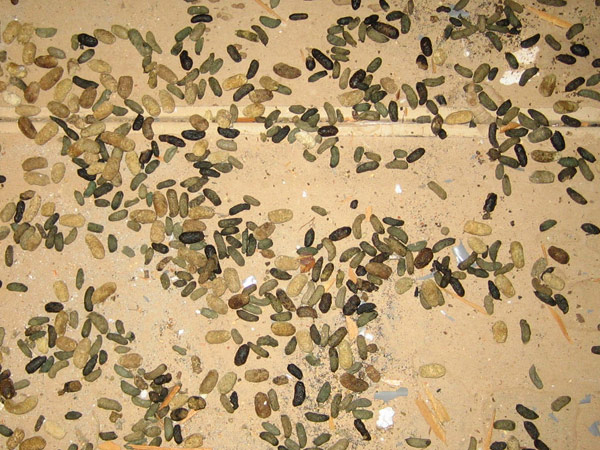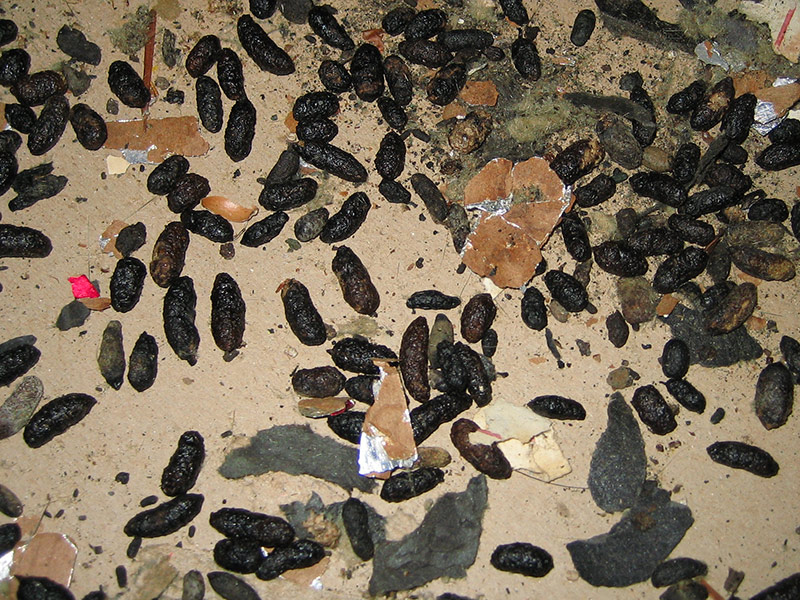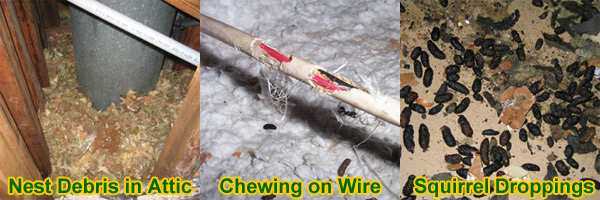- info@wildlife-removal.com
Call us for help in your town
Wildlife Removal Education
Photographs of Squirrel Poo
Need squirrel removal in your hometown? We service over 500 USA locations! Click here to hire us in your town and check prices - updated for year 2025.
NEED HELP? EMAIL ME! poop@wildlife-removal.com
Email me a photo of the animal feces you found, and I'll tell you which critter made it!
The below photos should help you properly identify the animal poop that you
see. These are pictures of squirrel poop. If you see these types droppings in
your attic or yard, they were made by a squirrel.
SQUIRREL POOP DESCRIPTION: Oblong pellets, usually about 3/8 inch long and 1/8 inch in diameter, rounded tips and slightly bulging in the center. with some size variance. Fresh ones are dark brown, but they get lighter with age.
Looks very similar to rat, only a little bit fatter, and a little more likely to grow lighter with time.

The above image of squirrel feces was photographed in the attic of a house with a squirrel problem. I was able to identify the type of animal by inspecting the turds. Once I know what type of critter is in the house or
the crawlspace, ceiling, yard, or any other part of the property, I can take the proper steps to get rid of the unwanted wildlife. Read the guide Best Way to Clean Squirrel Poop Out the Attic.
Does squirrel poop cause any health risk or disease concerns? Yes, the usual wildlife excrement health risks, such as leptospirosis or Salmonella.

I have more pics of squirrel poop here on my website, or I can send some more to you if you write to me at poop@wildlife-removal.com. I don't think anyone else out there has as many images of squirrel poop and droppings as me - I often take photos of animal
droppings to show the customer what kind of animal they have, and so that they can decide if they need me to clean up the squirrel waste, the scat and urine, and decontaminate. If you need to know how to identify squirrel poop, pictures
such as the ones above are the best bet, but you can take a photograph and send it to me, and I'll tell you what kind of animal droppings you have. Read more about Squirrel Feces — How Dangerous Is It?
How do I clean up the squirrel latrine? You must remove as many of the droppings as you can, by hand or vacuum, including any soiled and dirty insulation and bag it in plastic bags. Be sure to wear gloves and a HEPA respirator mask, and even a Tyvek suit. I then spray / fog the area
with a special enzyme cleaner, but any good disinfectant will suffice. Read more info on my: attic cleanup and restoration page.

Click here for my full guide on
how to get squirrels out of the attic for advanced tips and advice
Or my original squirrel removal page with various basic information
Or my comprehensive squirrel trapping tips page.
Facts About Squirrel Droppings -
Although you may not see rodents in your home one sure fire way to know that you have a pest problem is by finding squirrel droppings. Squirrel droppings can be confused with mouse droppings in that they are small
but where mice droppings are about the size of rice, squirrel droppings are more the size of a small bean, about a quarter inch long. They do tend to be a bit darker in color and the places where you will find them will be different. When you have mice problems you will find the droppings in places where you store food like pantries. Squirrel droppings on the other hand will mostly be close to the entrance and exit the squirrel uses to get into your home, and possible hiding places.
When you do find squirrel droppings you should clean them right away to avoid the spread of disease and if at all possible hire a professional to help you find and get rid of the squirrel. The cleaning part can be done with a rag or paper towels and some specialty cleaner or bleach. It is always recommended that you do not come into contact with the droppings so you should use rubber gloves while cleaning them. Also work at getting rid of the squirrel problem by placing traps throughout the location.
What Eats Away Squirrel Feces -
If you've had squirrels living in your attic, or if you are moving into a new home there is a chance that you will find rodent feces in it which you will need to clean. There are special enzyme-based sprays
that can dissolve these feces, basically by breaking down any organic matter, such as squirrel droppings, urine, etc. There are also ways to clean the spots whether it is on carpet or wood and that will leave
no trace of the fecal matter. The first thing you want to make sure that you do is to wear rubber gloves so that you do not have direct contact with them.
If you are trying to get feces off carpet then vacuum and scrape the area. Then place warm paper towels on top of it and leave it there for a few minutes. The paper towels will absorb the remaining traces.
Lift the paper towel from the center of the spot upwards while still wearing gloves and use carpet cleaner to finish the job. On solid floors such as wood the process is much easier. Pick up the solid feces
while wearing your gloves and mop the area. Wood floors are more resistant than carpet use a 1/3 bleach and 2/3 water to kill the germs.
Customer email about squirrel poo:
Hi, David! Thanks for writing the most erudite, credible, and detailed information on this site. Working my way through dozens of useless ones last night, I was thrilled to stumble onto your writing and photos. Yesterday I discovered insulation
all over my front yard and there were small animal droppings in the insulation. Based on your photographs, I am almost certain that the droppings were made by a squirrel. I was able to make out a small hole where the front stone wall of my house met the soffit under the roof. It looks like it/they ate out the mortar. It would be terribly
difficult to attach an exit trap to that small a hole in that location. For various reasons that seemed well-thought out at the time, I closed up the hole. But after reading your site, I realize there's obviously a mother squirrel up there, so I put out a big hav-a-heart trap and something ate the bait. I was going to follow your advice and leave them all there until they're grown, but I just read another post somewhere about the terrible smell of their "bodily excretions" all over my wood floors, insulation, boxes, etc.
David, I throw myself and my future onto your experience, insight, and genius. You're the squirrel guru, I'll follow your advice without complaint, whatever it is. Which would be worse: the expense (I'm broke, unemployed, cancer, divorced, old - sounds attractive, no?) of cutting many holes in the walls and potentially damaging all the soft giant a/c piping by the trapper or the squirrels and the trapper fee, vs. the smell of squirrel pee and poop in the insulation, wood, etc.?? Thank you so, so much for being there! Yours sincerely, Jayne
My response: You certainly don't have to cut holes in any walls. You can wait until the young are old enough to move on their own, then set a one-way exclusion door on the entry/exit hole. You can definitely wait for them to grow up - the odor is almost nothing. There's no way anyone, you included, would ever notice any scent, unless one of the squirrels died, in which case you'd notice a strong odor.


















